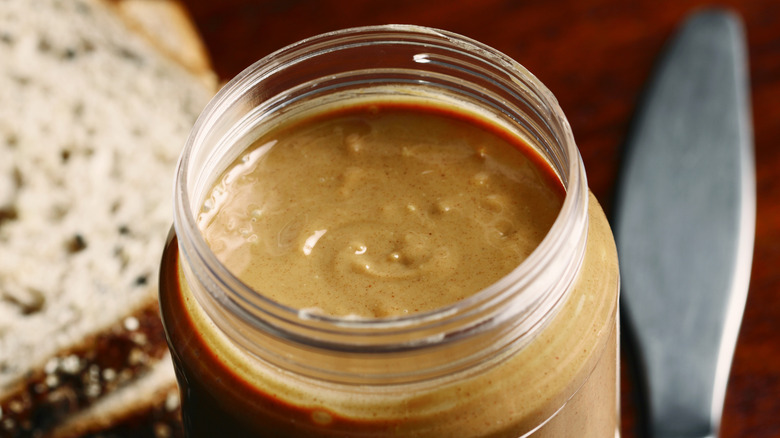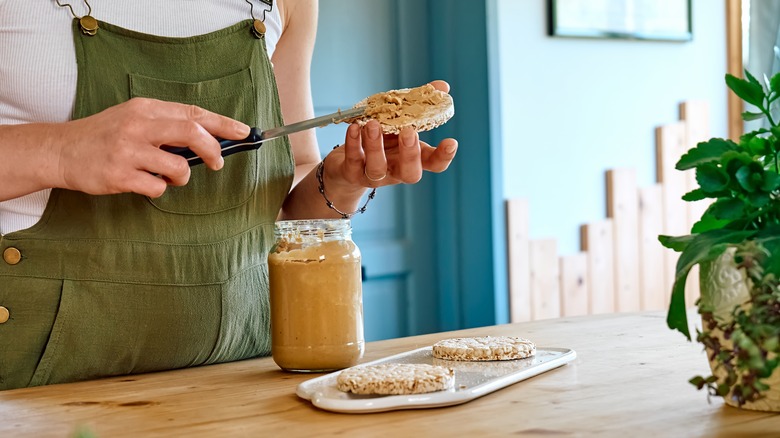How Long An Open Jar Of Peanut Butter Lasts In The Pantry
No pantry — or kitchen for that matter — is complete without peanut butter. And for most of us, the problem isn't about how long the peanut butter will last, it's about how to make its deliciousness last longer than a week. But in the event that you don't power through a jar of the delectable nut butter in record time, or if you find yourself with a forgotten jar lingering in the back of the pantry, you may be surprised to learn that yes, even this quintessential snack and sandwich spread can indeed go bad.
Many variables impact how much time you have before your crunchy or creamy jar of goodness will turn, and some preparation habits and storage tips can help to greatly prolong its lifespan. Because really, most of us can agree that it's basically a crime to toss PB. In general, according to the USDA, you have a window of around three months after opening a jar of peanut butter to use it up, after which point it will sour and turn musty and funky. If upon opening a jar you notice a whiff of something stale, or if the taste is bitter (or in any way off), you can be sure that it's not your imagination — unfortunately, that peanut butter is past its prime.
Conventional and natural peanut butters age differently
Though a peanut butter and jelly sandwich is an absolute staple for all ages, and just about everyone loves the concept of spreadable roasted peanuts, that's where the agreements end. There's team crunchy and team creamy. There are those who only eat all-natural peanut butter — which contains one or two ingredients, peanuts and salt — and those who prefer other conventional types of peanut butter with added oils and preservatives.
Personal preferences aside, conventional jars of peanut butter require less stirring and have a slightly longer shelf life. While even conventional peanut butter, once opened, only lasts around three months in the pantry, natural varieties can go bad in as little as one month. You may not see visible signs of rot (like mold) in peanut butter that's turned, though it is possible. Use your senses to tell if it's time to toss — like smelling for an off or stale odor, or checking the texture. Especially in the case of all-natural butter, the typically creamy and spreadable texture may take on a dry, cakey pastiness and a darker-than-usual color when it's gone bad. This is totally different from the normal separation of all-natural PB, which is completely safe and to be expected — it just means that you need to re-stir the jar. If you attempt to stir and the texture is still dry or difficult to work with, this is a sign that it may be at the end of its lifespan.
Keep peanut butter refrigerated for a long lifespan
Peanut butter is delicious, high in protein and healthy fats to keep you fuller longer, and — as with most grocery store prices these days — not cheap. Lately, we're all looking for ways to save at the grocery store, but saving money also starts with how we reduce food waste at home. One easy way to pad out the life expectancy of whatever type of peanut butter you grab at the store — whether it's crunchy or creamy, natural or conventional — is to store it in the refrigerator once opened, so you're less likely to waste it.
For natural varieties that don't contain any added preservatives or stabilizing oils, they should always be stored in the fridge vs. the pantry. This can boost the prime time of peanut butter from two to three months to up to nine months, so it's a no-brainer. Refrigeration can also help keep your natural peanut butter from separating, because who likes having to re-blend it every time you reach for the jar? While you aren't required to keep conventional peanut butter in the fridge, doing so will absolutely help it stay good for longer, which buys you another couple of months to finally make those homemade peanut butter cookies.


